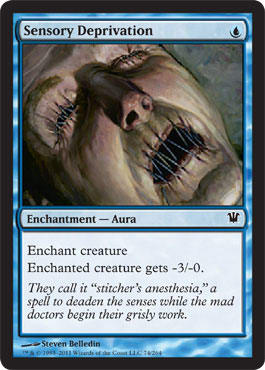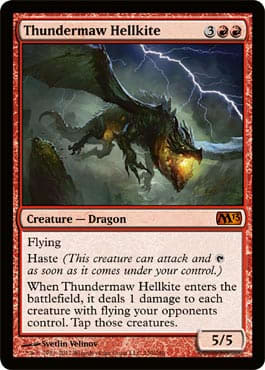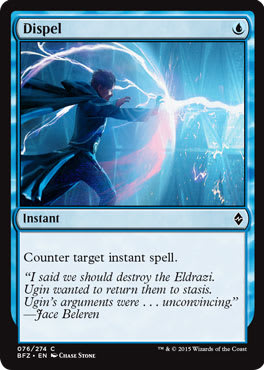Hey there! I hope you liked my insights on the Twin archetype last week, and if you haven’t read it yet, be sure to give it a look in case you are interested in the Modern format. This week, I’m taking an experimental approach to writing by tuning an existing decklist to perform even better. If this goes well, I’ll consider using the same approach in the future.
Start It Up!
I started preparation for this roughly a week ago, having played zero games of the new Standard format. I wanted to try a deck out, but I didn’t have any idea where to start and which deck to choose. I had read a bit about what other writers had to say about the format, and after looking at various decks, I decided to try out the Bant control deck, as it seemed right up my alley. Then, I came up with the idea of combining this deck-selection process with my writing process into an experiment in deck tuning.
The process I want to try out was as follows:
- Pick a list from the Daily Events decklists.
- Play the list as-is (without making any changes) in two-man queues and Daily Events.
- Make notes about cards and matchups, trying to find out which are good and which are bad.
- Make changes to the deck based on the observations.
- Play some more games and repeat the process of taking notes and changing the deck.
Now, for anyone familiar with deck-building and brewing, this will probably sound very familiar. The idea of constantly reiterating a decklist, making changes as you go along, is pretty much the whole premise of developing a deck. However, I though adding the twists of choosing an already tuned list played by someone else would add a new element to the process.
Here is the list I started out with. Unfortunately, I forgot to write down the name of the person who had played this deck to a 4–0 result, so sorry about not giving credit where credit is due.
"Bant 1.0"
- Creatures (12)
- 2 Angel of Serenity
- 2 Centaur Healer
- 4 Restoration Angel
- 4 Thragtusk
- Planeswalkers (4)
- 4 Jace, Architect of Thought
- Spells (19)
- 2 Syncopate
- 3 Azorius Charm
- 3 Sphinx's Revelation
- 4 Farseek
- 4 Supreme Verdict
- 3 Detention Sphere
- Lands (25)
- 1 Forest
- 1 Plains
- 2 Island
- 2 Cavern of Souls
- 3 Glacial Fortress
- 4 Hallowed Fountain
- 4 Hinterland Harbor
- 4 Sunpetal Grove
- 4 Temple Garden
- Sideboard (15)
- 2 Sensory Deprivation
- 2 Negate
- 2 Rest in Peace
- 2 Dissipate
- 2 Centaur Healer
- 1 Cavern of Souls
- 1 Ray of Revelation
- 1 Garruk, Primal Hunter
- 1 Sigarda, Host of Herons
- 1 Syncopate
I tried not to have too many preconceived notions regarding the card selection, but a few of the choices for the sideboard seemed a bit off. I decided to trust the original list, and I started battling.
The first two-man queues went well, and I managed to go 3–1 in the first Daily Event. I wrote quite a lot of notes in the beginning, so here are some of the observations that I made regarding both single-card choices and matchups.
Single-Card Notes
- Angel of Serenity was even better than I expected, and I never board it out. It’s the single best card in the deck, as it helps you get out of some really problematic situations that no other card can.
- Sensory Deprivation seemed quite bad. I understand that it is good to have a pseudo-removal spell for 1 mana against decks like mono-red, but the fact that you are running sweepers makes it quite a lot worse. It’s also not the best since the creature still triggers Hellrider.
- Rest in Peace was amazing. I had some reservations the first time I played against W/U Flash and was not quite sure if Rest in Peace would be good enough, but I sideboarded it in anyway. It took just a handful of turns to figure out just how insane the card is in the matchup. I’ll cover these aspects more when I talk about the actual matchup.
- Syncopate was often a bit awkward, and I wondered if it wouldn’t just be better to run Dissipate instead.
- Negate was decent, but perhaps Dispel could be played since it’s often much better in the control mirrors.
In general, it’s worth playing fast with this deck. I managed to time out for the first time in many years, and it was a bit frustrating. I was playing against some form of reanimator, and the game was super-grindy with multiple copies of Angel of Serenity on both sides of the table. In the end, I lost to timing out, needing only one more attack to win. My opponent was left with thirty seconds on the clock, so it was very close.
Matchup Notes
I won’t be doing a full matchup review, but rather, I’ll just present the notes I gathered while trying out the deck. I did play against a fair number of different decks, though, so if there is anything in particular you would like more information about, just ask!
Mono-red is a very good matchup. I’ve lost to it once, and that was mainly due to being mana screwed. Mono-red is very fast, so naturally, it is possible to be run over, but I would assume Bant has among the best matchups against the deck among the popular Standard decks. Being able to go up to eight life-gain creatures after sideboarding is huge. The only real problem cards are Thundermaw Hellkite and Hellrider, so try to save a removal spell for those if possible.
W/U Flash is a bit of a tough matchup. Cavern of Souls is your best card here, and it’s usually best to name Beast. After sideboarding, things become a bit better, as you have fewer bad cards, and the opponent is probably not bringing in all that much against you. The card you most often lose to is Runechanter's Pike, which means Rest in Peace is super-good here. It also shuts down Snapcaster Mage, Moorland Haunt, and the flashback cost of Think Twice, so even though the enchantment is card disadvantage, it gives you virtual card advantage once the game goes long.
Reanimator can be tough in the first game, especially if it’s the Craterhoof Behemoth version. The other versions can’t kill you out of nowhere, so you always have the option of playing Supreme Verdict. After sideboarding, things become a lot better, as you have more counterspells and Rest in Peace, which shuts many of reanimator’s cards down quite handily.
Other midrange decks feel like good matchups, as do aggro decks such as G/W Humans.
Making Changes
I decided I wanted some more cards against W/U Flash, as it seems to be popular both online and in real life. I started by cutting the two Sensory Deprivations to make room for two Loxodon Smiters. I also cut the one Syncopate from the sideboard to have room for one Righteous Blow, as I still wanted at least one cheap removal spell against mono-red. I also swapped out one Syncopate from the main deck and tried out a Dissipate in its place.
When I played with this new version, W/U Flash seemed to be a better matchup. Being able to put on some pressure is really valuable in the matchup, and Loxodon Smiter does that very well. Having pressure on the board means the opponent has to react, giving you the opportunity to resolve your more powerful spells past the deck’s countermagic. Actually fighting through all the counters is almost impossible, so you have to find a way to avoid it.
Going Forward
I haven’t yet had to time to try a third iteration of this deck, but I have some ideas of what I would like to change. I would try out two Loxodon Smiters in the main deck over the two Centaur Healers, as they seem to be better in most matchups. Centaur Healer is much better against mono-red, but as that is already a good matchup, I feel you can give up a few percentage points there to make others matchups better. A thing worth considering is whether you should even be running these random creatures in the main deck or whether they should just be something that works better with the control strategy. For the time being, I feel it’s good to be able to play different roles in different matchups, so the added flexibility compensates for the loss in focus.
I would also cut the last Syncopate in favor of a second Dissipate, as I feel that Dissipate is better most of the time. I diversified the counterspells in the sideboard, adding a Dispel to go along with the third Dissipate and two Negates. Sigarda, Host of Herons has not been very impressive, so I think you could try out a single Elixir of Immortality in the sideboard against all the other heavy-control decks.
Here is the list I would suggest playing going forward.
"Bant 3.0"
- Creatures (12)
- 2 Angel of Serenity
- 2 Loxodon Smiter
- 4 Restoration Angel
- 4 Thragtusk
- Planeswalkers (4)
- 4 Jace, Architect of Thought
- Spells (19)
- 2 Dissipate
- 3 Azorius Charm
- 3 Sphinx's Revelation
- 4 Farseek
- 4 Supreme Verdict
- 3 Detention Sphere
- Lands (25)
- 1 Forest
- 1 Plains
- 2 Island
- 2 Cavern of Souls
- 3 Glacial Fortress
- 4 Hallowed Fountain
- 4 Hinterland Harbor
- 4 Sunpetal Grove
- 4 Temple Garden
- Sideboard (15)
- 2 Negate
- 2 Rest in Peace
- 1 Dissipate
- 1 Dispel
- 3 Centaur Healer
- 1 Loxodon Smiter
- 1 Righteous Blow
- 1 Cavern of Souls
- 1 Ray of Revelation
- 1 Garruk, Primal Hunter
- 1 Elixir of Immortality
Our Work Is Never Over
Tuning a deck to perfection requires countless iterations, and in Magic, this never stops. The metagame constantly changes, and your deck needs to reflect this. By playing on a regular basis, you form a good understanding of the metagame and are able to change your deck accordingly. I hope this article gave you some insight into how I personally approach deck development. The process can vary from time to time, depending on if you are working on a deck for a new format or are tuning a deck in an environment that already has a metagame and decks to beat.
I’ll be playing some more with this deck on Magic Online, so perhaps I’ll return to it in a few weeks and see how things have changed. For all of you looking for a deck to try out, I warmly recommend this Bant control. I love control decks, and chaining multiple Sphinx's Revelations sure feels nice. Acquiring the cards can be a challenge, however, as there are quite a lot of rares and mythics involved.
As always, all kinds of feedback and comments are appreciated. Feel free to get in touch either via the comments section or through Twitter; you can find my Twitter handle at the bottom of this article.
Thanks for reading,
Max
@thebloom_ on Twitter
Maxx on Magic Online
You can find my music on: http://soundcloud.com/bloomlive

























